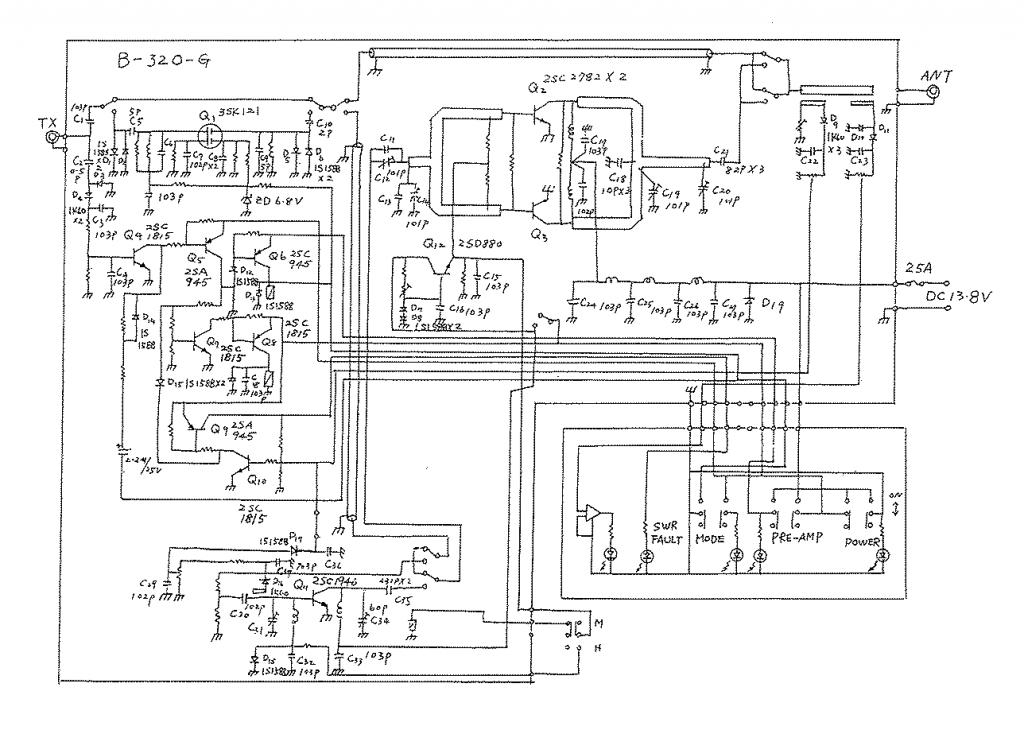I've needed (wanted) a 2 meter amplifier for some time and finally decided to purchase the Mirage B-320-G 200 watt amplifier. The B-320-G is an interesting design because it is capable of producing 200 watts by driving it with either a 50 watt mobile, or a 5 watt Handi Talkie! I intend to purchase the 2 meter option for the Elecraft KX3 which will produce around 10 watts, so this amplifier will give me the versatility to deliver higher power on 2 meter SSB with the KX3 or when driven from my Yaesu FRM-350 in the shack.
Here are a few pictures of the amplifier:
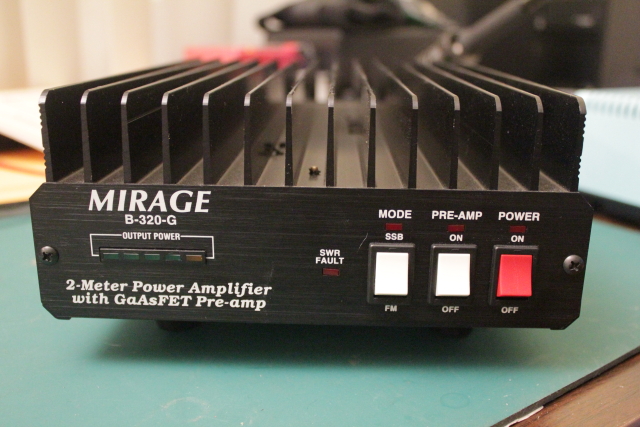
As you can tell by looking at the face, the amplifier is switchable between SSB and FM without having to pull the covers off. I previously owned a TE Systems VHF amplifier, and having to open it up to switch to SSB mode was ridiculous.
The rear of the amp is pretty basic, but notice the switch to the far left:
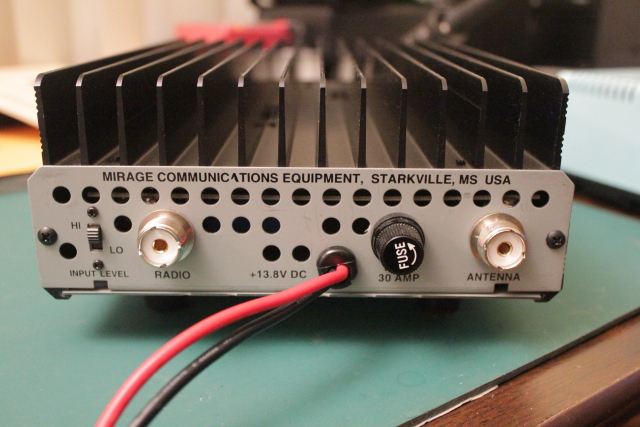
This is the switch you flip based on the amount of drive you are going to deliver into the amp.
The bottom of the amp contains the fan that blows the hot air out, drawing cool air in through the vents.
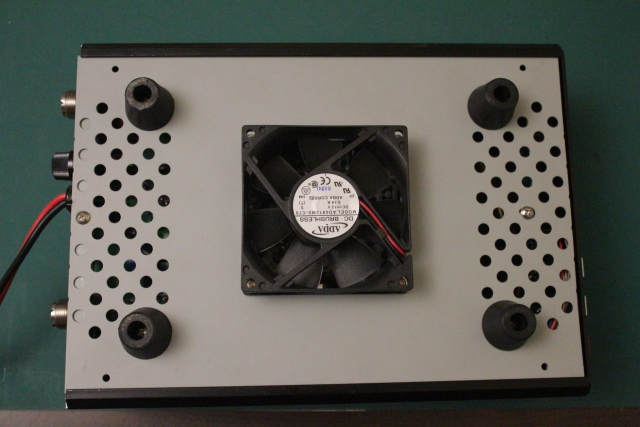
The heat sink is quite tall and wraps around the sides of the amp. I can honestly report based on some quite long rag chews at full power, that it is very difficult to get this amplifier hot under normal usage.
Opening the case to peek inside involves removing the feet, sliding the bottom over a bit and de-soldering the fan leads. After the fan leads are free, you can slide the case off, flexing the base a bit to clear the fan screws. Now the inside is revealed:
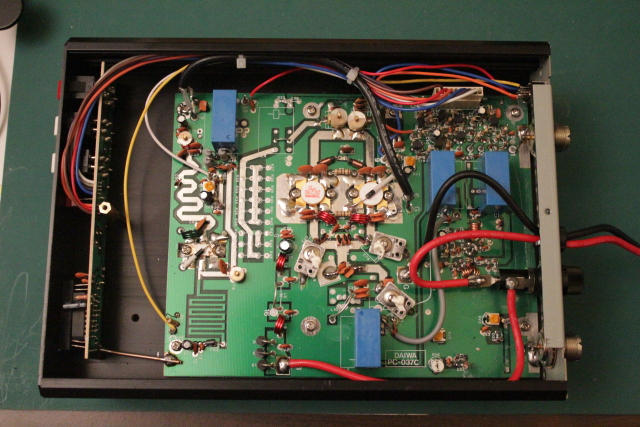
The primary source of power amplification comes from a pair of 2SC2782 transistors.
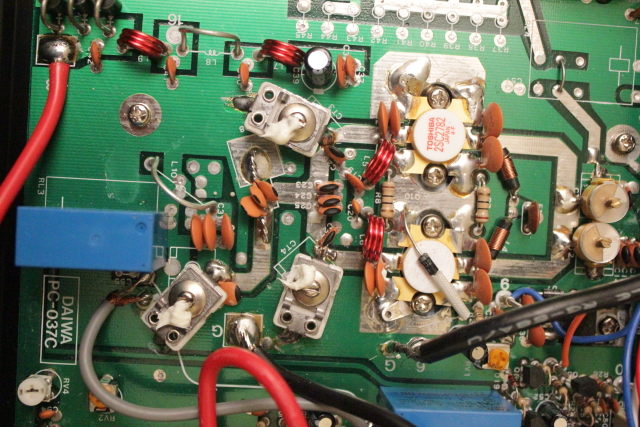
These transistors are rated right at 100 watts out power output at 14 volts when driven with about 18 watts:
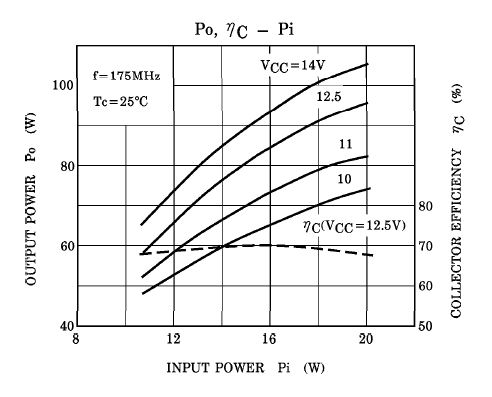
The power output rating actually increases a bit as the frequency is brought lower into the 2 meter band.
I'm not an engineer and my schematic reading skills are pretty poor, but it appears to me by reading the schematic that when in the low-drive setting, the 2SC1946 transistor shown under these wires is switched inline to drive the main transistors:
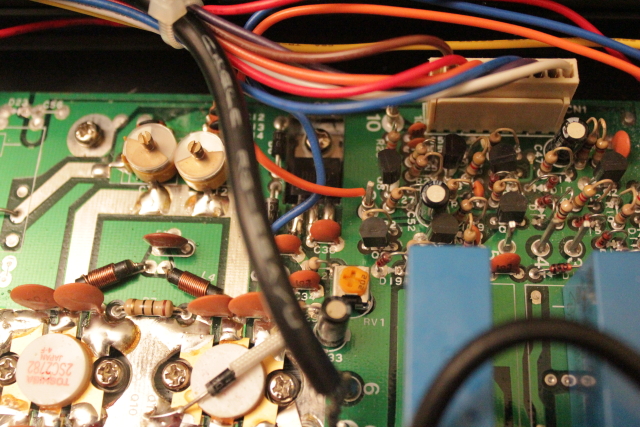
Here are drive / output figures that Mirage publishes for this amplifier. I verified these numbers with my own equipment by testing with both a mobile and an HT and found them to be right on:
Low drive input / Output (watts)
Input|Output
0.25|132
0.5|165
1|175
2|190
3|200
High drive power input / Output (watts)
Input|Output
0.25|1.5
0.5|4
1|10
2|24
3|32
5|48
6|64
8|82
10|95
15|135
20|148
25|165
35|186
50|200
The amplifier also features a selectable 15db GaAsFET receive pre-amp which really does a nice job helping with weak stations, as well as SWR fault protection. While it comes with a mobile bracket, there is no remote head available, so you will need to fabricate your own if necessary. Mirage does provide optional remotes with most of their other models, so it would be nice if they would add a factory option for this one, as well.
Priced at nearly $500, this amplifier is not inexpensive. However, that price tag gives you quite a bit of flexibility, allowing you to use this amp under a number of different scenarios. I've been using it constantly at full power and I'm continually impressed with how it performs. In fact, I usually have to give my transceiver a break first because it gets too hot faster than this amp does!
All things considered, I like this amplifier very much.
Here are a few pictures of the amplifier:

As you can tell by looking at the face, the amplifier is switchable between SSB and FM without having to pull the covers off. I previously owned a TE Systems VHF amplifier, and having to open it up to switch to SSB mode was ridiculous.
The rear of the amp is pretty basic, but notice the switch to the far left:

This is the switch you flip based on the amount of drive you are going to deliver into the amp.
The bottom of the amp contains the fan that blows the hot air out, drawing cool air in through the vents.

The heat sink is quite tall and wraps around the sides of the amp. I can honestly report based on some quite long rag chews at full power, that it is very difficult to get this amplifier hot under normal usage.
Opening the case to peek inside involves removing the feet, sliding the bottom over a bit and de-soldering the fan leads. After the fan leads are free, you can slide the case off, flexing the base a bit to clear the fan screws. Now the inside is revealed:

The primary source of power amplification comes from a pair of 2SC2782 transistors.

These transistors are rated right at 100 watts out power output at 14 volts when driven with about 18 watts:

The power output rating actually increases a bit as the frequency is brought lower into the 2 meter band.
I'm not an engineer and my schematic reading skills are pretty poor, but it appears to me by reading the schematic that when in the low-drive setting, the 2SC1946 transistor shown under these wires is switched inline to drive the main transistors:

Here are drive / output figures that Mirage publishes for this amplifier. I verified these numbers with my own equipment by testing with both a mobile and an HT and found them to be right on:
Low drive input / Output (watts)
0.25|132
0.5|165
1|175
2|190
3|200
High drive power input / Output (watts)
0.25|1.5
0.5|4
1|10
2|24
3|32
5|48
6|64
8|82
10|95
15|135
20|148
25|165
35|186
50|200
The amplifier also features a selectable 15db GaAsFET receive pre-amp which really does a nice job helping with weak stations, as well as SWR fault protection. While it comes with a mobile bracket, there is no remote head available, so you will need to fabricate your own if necessary. Mirage does provide optional remotes with most of their other models, so it would be nice if they would add a factory option for this one, as well.
Priced at nearly $500, this amplifier is not inexpensive. However, that price tag gives you quite a bit of flexibility, allowing you to use this amp under a number of different scenarios. I've been using it constantly at full power and I'm continually impressed with how it performs. In fact, I usually have to give my transceiver a break first because it gets too hot faster than this amp does!
All things considered, I like this amplifier very much.

